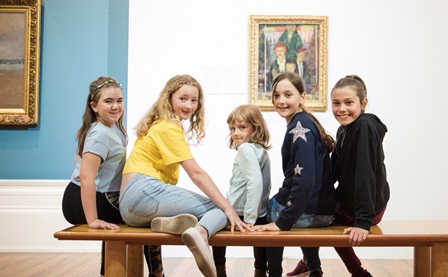Art
Our art collection was founded in 1883 with Richard Newsham’s bequest to Preston of his remarkable Victorian art collection.
The Harris’ fine art collection includes oil paintings, watercolours, drawings, prints, sculpture and books, from the 12th century to the present day.
The museum received a steady stream of gifts from the Contemporary Art Society from 1910 onwards. From the early 20th century to the late 1960s, the Preston Corporation made annual purchases for the collection from the Royal Academy. Since 1985, the Harris has acquired works by contemporary British artists through funding from Preston City Council, the Friends of the Harris, the Contemporary Art Society, the Art Fund, Arts Council England, the DCMS/V&A Purchase Grant Fund and the Granada Foundation.
More information on our Fine Art
Download Fine Art Information
Date
This collection is open all year round, however if you would like to check a certain piece is on display, email theharris@preston.gov.uk.
Location
This collection is located on the 2nd floor Fine Art gallery.
Cost: free
This collection is free to visit
Exploring Art
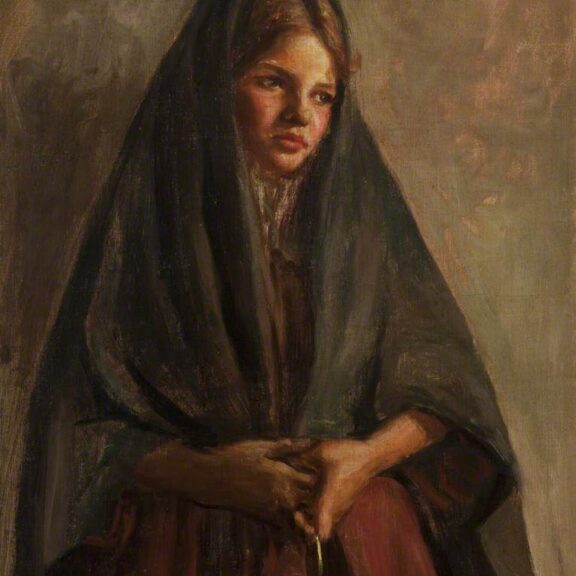
The Half-timer (Portrait of Annie Hill)
Date: 1906-1908
Object number: P2361
Artist: Patti Mayor
Annie Hill was 12 years old when Mayor painted this portrait. She worked as a half-timer at Horrockses cotton mill, splitting her day between work and school.
It was unusual at the time for working women to have their portraits painted. The painting was carried in the Women’s Sunday march in London in 1908 to represent thousands of working women and children like Annie. It played an important role in the campaign for women’s suffrage, helping to demonstrate that women contributed their labour and taxes to the country and should have a say in the country’s politics.
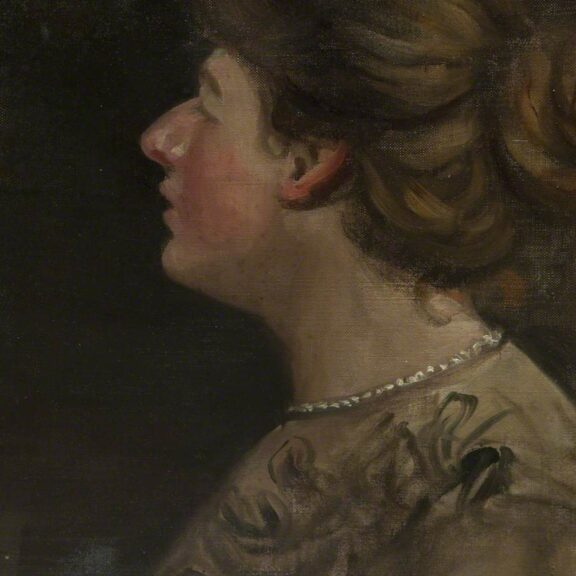
Self Portrait
Date: In the 1920s
Object number: P1179
Artist: Patti Mayor
This self-portrait was probably painted in the 1920s. Patti was a popular Preston born artist who painted the portraits of many local people.
She attended the Slade School of Fine Art, one of the UK’s most prestigious art schools, and was a member of the Women’s Social and Political Union, better known as the Suffragettes
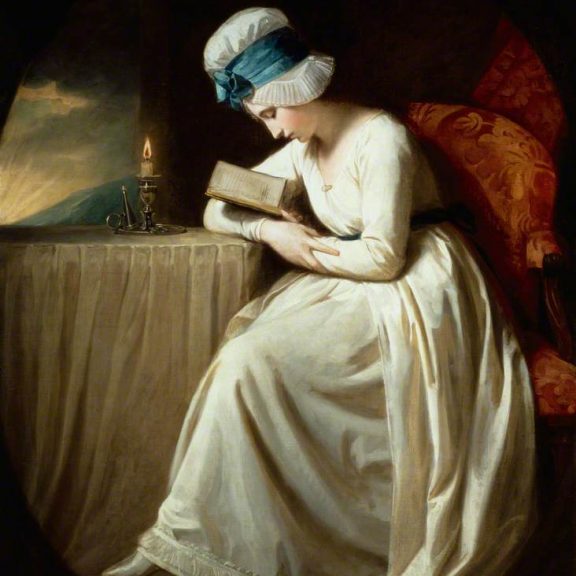
Serena Reading
Date: around 1780-85
Object number: P2365
Artist: George Romney
‘Serena Reading’ shows the heroine from a poem called ‘Triumphs of Temper’ by William Hayley, a close friend of Romney. The poem tells how Serena became so engrossed in a book that she read all through the night. Daylight is breaking and her candle has burnt down. Romney was born near Dalton-in-Furness, Cumbria, but moved to London, where he was the most fashionable portrait painter of his era.
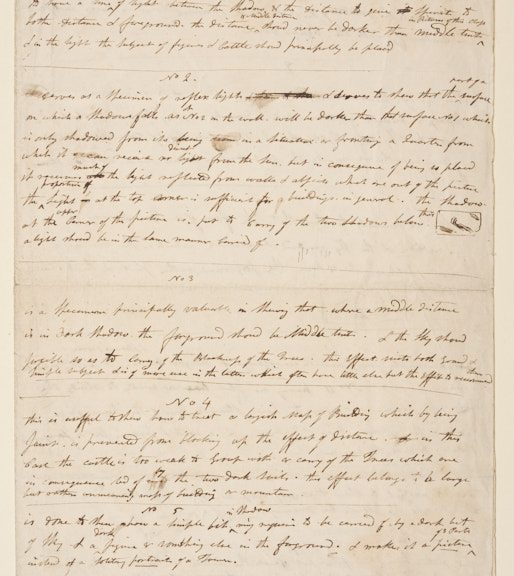
Manuscript of Instructions for Drawing
Date: about 1818
Object number: P1001.3
Artist: John Varley
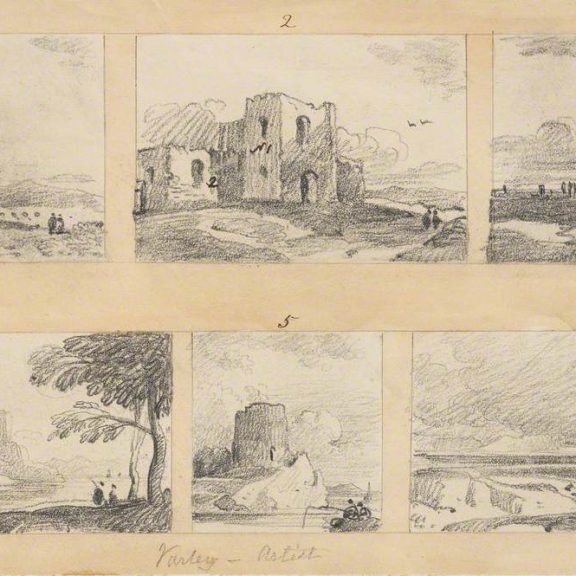
Sketches of Instructions for Drawing
Date: about 1818
Object number: P1001.2
Artist: John Varley
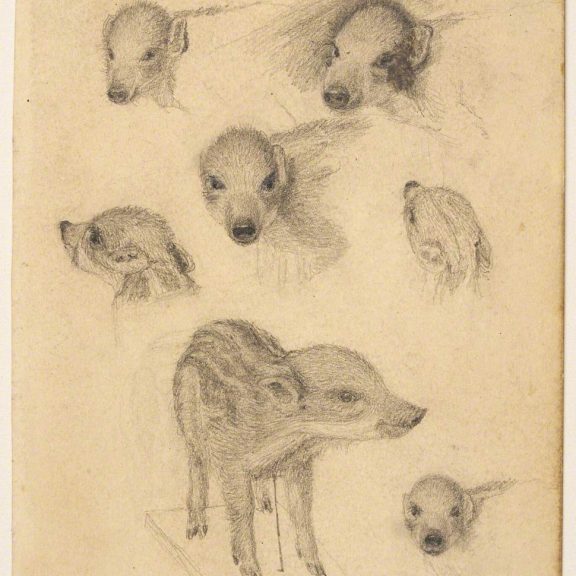
Iron Age Piglet
Date: about 1870
Object number: P1126.6
Artist: Joseph Wolf
Wolf was a German-born artist. He settled in England in 1848 and is described as the most successful natural history painter of his generation. He pursued his art according to the principle that ‘we see distinctly only what we know thoroughly,’ and paired exacting detail with a determination to capture the liveliness of his subjects.
He provided illustrations for many noteworthy organisations including the Zoological Society, skilfully bringing together the best attributes of science and art. Wolf was admired for treating his subjects as individual and distinct, rather than just examples of a species. A large number of his studies are held at the Victoria and Albert Museum in London.
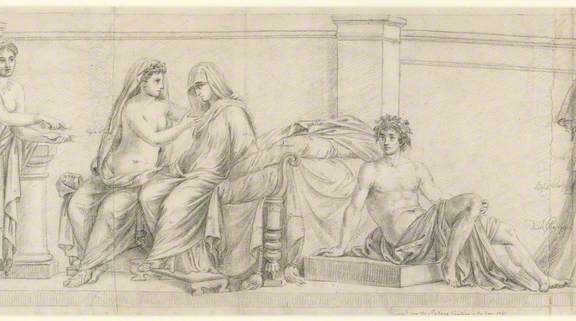
Study after the Aldobrandini Wedding
Date: 1763
Object number: P441
Artist: Joseph Nollekens
Nollekens went to Rome in 1762, where he studied and worked as an antique dealer and restorer, before returning to London in 1770.
This drawing is a study of an ancient fresco that was discovered in Rome in about 1600. There are a number of theories about the subject of the painting. One suggests that it represents the wedding of Peleus and Thetis, the parents of Achilles, the hero of the Trojan War.
Nollekens would have made this close study from the original fresco when it was still in the possession of the Aldobrandini family. It is now in the Vatican Museum’s collection.
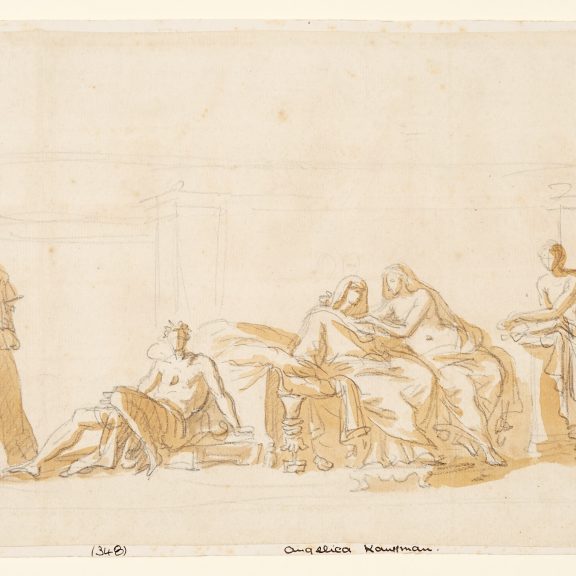
Study after the Aldobrandini Wedding
Date: about 1790
Object number: P348
Artist: Angelica Kauffman
As a woman, Kauffman was prohibited from drawing nude models. Instead she made studies of figures from paintings and sculpture. It is unclear when she saw the Aldobrandini Wedding, but this ancient Roman fresco, would have offered intriguing possibilities for studying drapery and the human form.
The drawing is made in reverse, indicating that Kauffman may have intended to make it into an engraving.
Kauffman was a Swiss-born painter who is best known for her portraits and historical subjects. She first visited Italy with her father in 1762, and returned to settle in Rome as an established artist some twenty years later. She was one of only two women invited to become Founding Members of the Royal Academy in 1768.
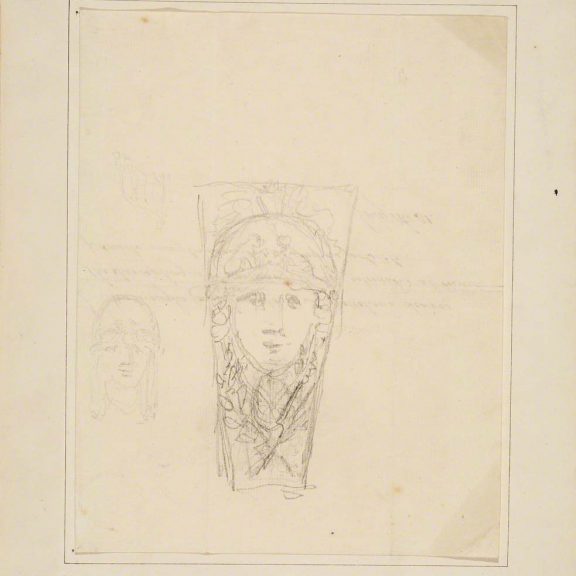
Sketch for a Keystone at Somerset House
Date: about 1795
Object number: P439
Artist: Joseph Nollekens
Nollekens designed some of the exterior decorative features for Somerset House in London. This drawing is an initial idea for the keystones that cap the arches near to what is now the entrance to The Courtauld Gallery. He made the sketch on the back of a letter relating to a commission for Lord Newborough.
The Courtauld Gallery moved to Somerset House in 1989. The building formerly housed the Royal Academy of Arts, where in 1772 Nollekens became a Royal Academician.
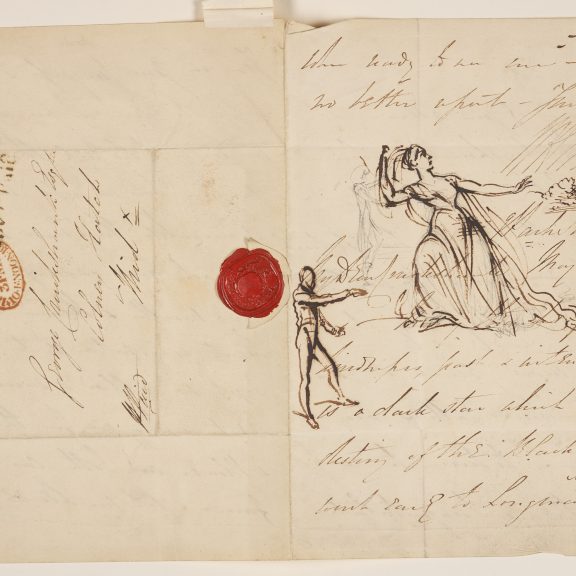
Sketches on a Letter
Date: about 1828
Object number: P1241.1
Artist: George Cruikshank
Nicknamed the ‘modern Hogarth’, Cruikshank was a popular Victorian caricaturist and book illustrator. This drawing is a collection of quick spur of the moment sketches made on the back of a letter dated 1828.
Cruikshank was best known for his satirical interpretations of modern life, often reflecting on the politics of the day. He was a good friend of Charles Dickens and illustrated several of his books, including Oliver Twist.
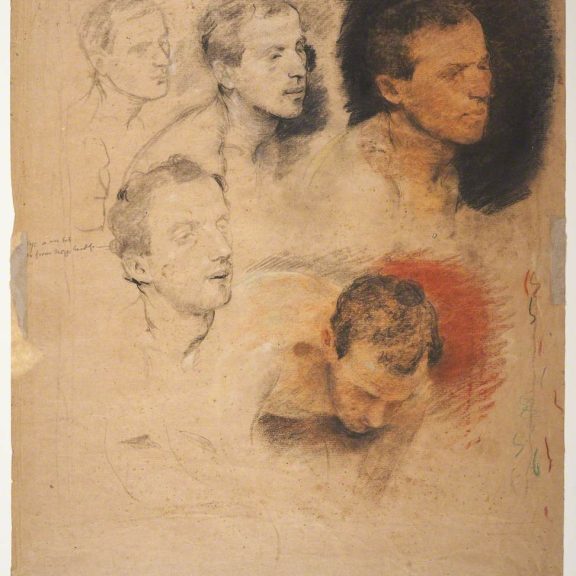
Study of a Male Head
Date: about 1890
Object number: P1584
Artist: William Edward Stott
This study captures a number of poses on a single sheet of paper. Stott was trying out different positions and experimenting with the effects of line, tone and colour. It could be an exercise in life drawing or an initial idea for a painting.
Stott was born in Rochdale, and was known by his middle name Edward to avoid confusion with the artist William Stott of Oldham.
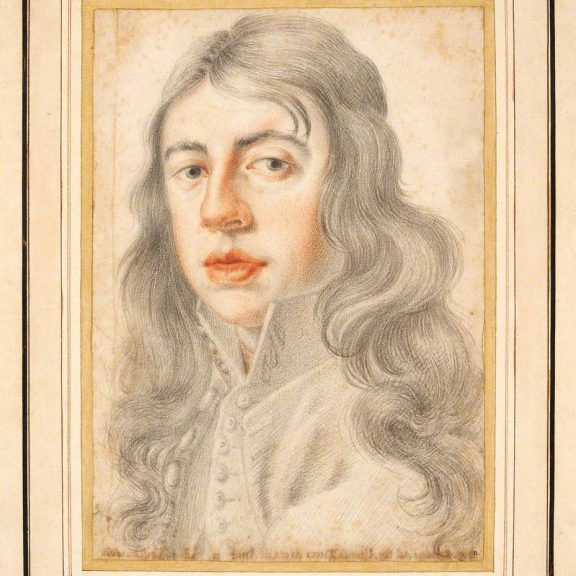
Presumed Portrait of Simone di Alfonso Tucci
Date: 1662
Object number: P743
Artist: Filippo Baldinucci
Baldinucci drew mostly portraits of his friends, all in roughly the same format. He combined delicate lines with subtle additions of red chalk to capture their likeness and showcase his draughtsmanship. This drawing, with its high degree of finish, was almost certainly intended as a presentation piece or a gift.
Baldinucci was an important artistic figure in 17th century Florence. He was employed as curator of the Medici family art collection, and published several books focussing on artists’ biographies.
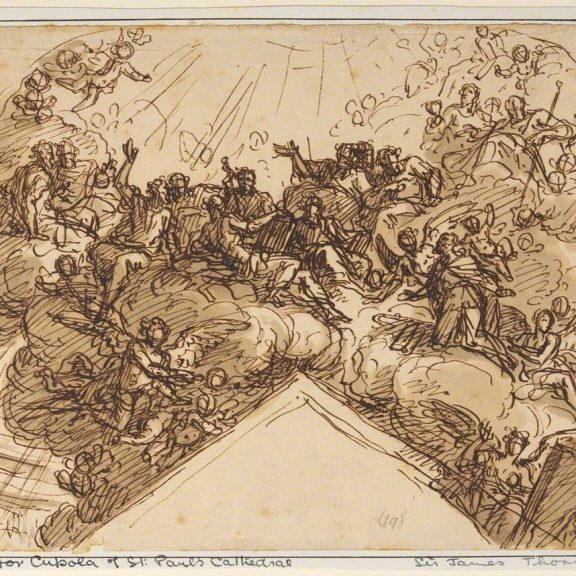
Design for the Cupola of St Paul’s Cathedral
Date: before 1715
Object number: P588
Artist: Sir James Thornhill
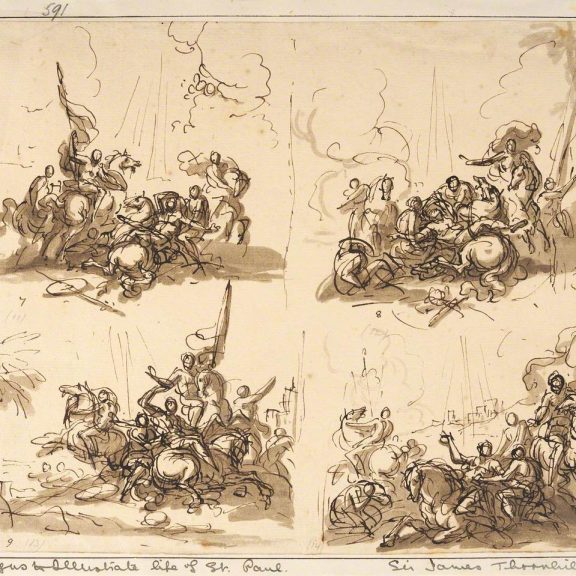
Four Designs Illustrating the Life of St Paul
Date: before 1715
Object number: P591
Artist: Sir James Thornhill
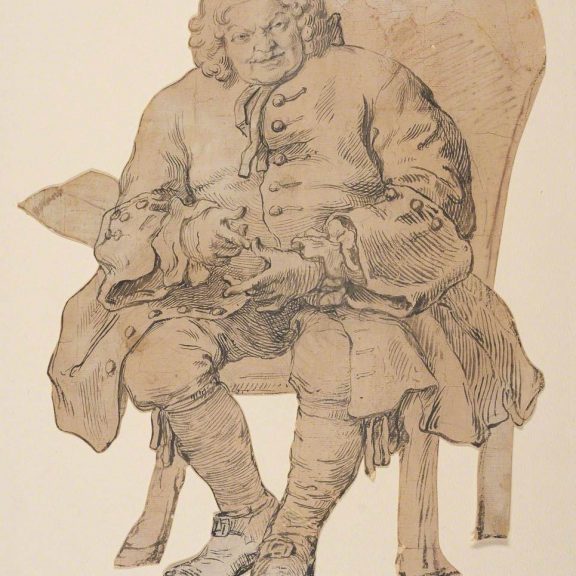
Simon Fraser, Lord Lovat
Date: 1746
Object number: P985
Artist: William Hogarth
Hogarth is best known for his satirical and moralising paintings and engravings. His observations of Georgian society were often witty and brutally honest. They were hugely popular and widely reproduced as prints.
Hogarth visited Lord Lovat when he was waiting to go on trial for high treason. This silhouetted drawing is most likely a preparatory sketch for the print on display to the right. The drawing was made in reverse. After etching and printing, the final image would appear as Hogarth intended.
Lord Lovat was known as ‘the most devious man in Scotland’ and nicknamed ‘the Fox’. Guided solely by self-interest, he switched his support back and forth during the Jacobite Risings. He was eventually found out in 1746 and executed the following year at Tower Hill for high treason.
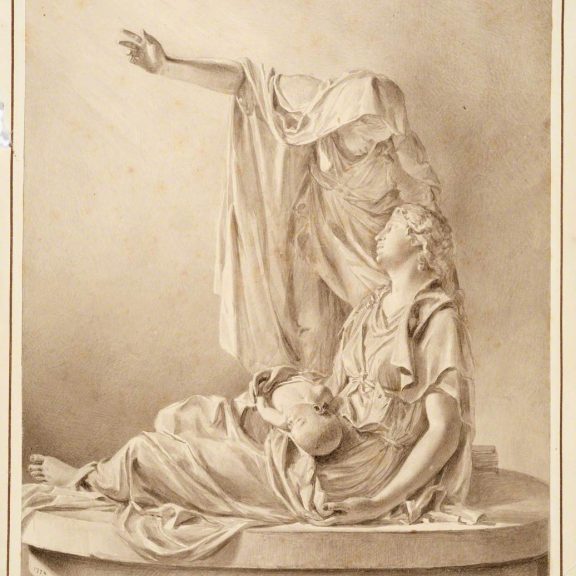
Monument of Mrs Howard
Date: about 1790
Object number: P442
Artist: Joseph Nollekens
Nollekens is one of Britain’s most celebrated sculptors. In the late 18th century his work was highly sought after by aristocratic patrons, who commissioned him to make portrait sculptures and memorials.
This is a drawing of what is considered to be his best work. Known as Faith, it is a memorial to Maria, who was the first wife of Henry Howard of Corby Castle, near Carlisle. They married in 1788. Maria died just a year later in childbirth, aged 23.
The memorial cost £1,500. It was installed near the castle, in Holy Trinity Church in 1803. The scene shows the dying mother with her dead infant daughter. She is supported by an angelic figure who represents her Christian faith.
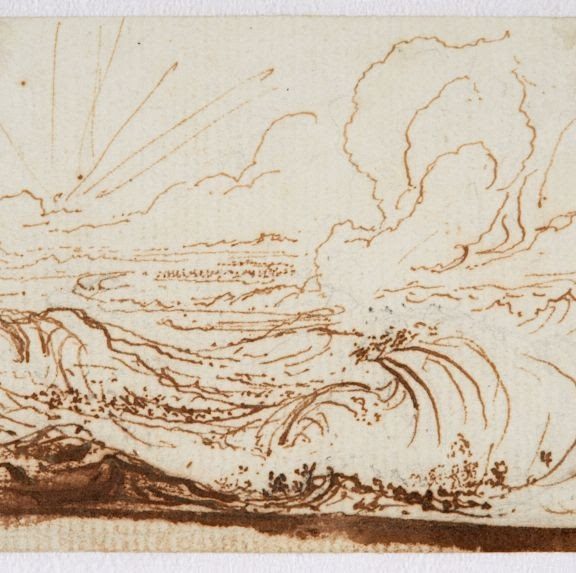
Destruction of the Pharaoh’s Host
Date: 1824
Object number: P745
Artist: John Martin
Martin is best known for his vast apocalyptic landscapes full of drama and spectacle. The subject depicted is the biblical story of Moses releasing the waters of the Red Sea, drowning the Egyptian army after allowing the fleeing Israelites to cross.
Despite the small scale of the drawing, the artist’s skilful penmanship brilliantly conveys the energy and epic scale of the unfolding drama.
The Harris has a painting that takes the same Bible story as its subject. You can see it on display at the top of the staircase in our virtual tour. It is by Francis Danby, who was a contemporary of Martin. Painted in 1825, The Delivery of Israel out of Egypt depicts Moses parting the Red Sea, allowing the Israelites to cross.
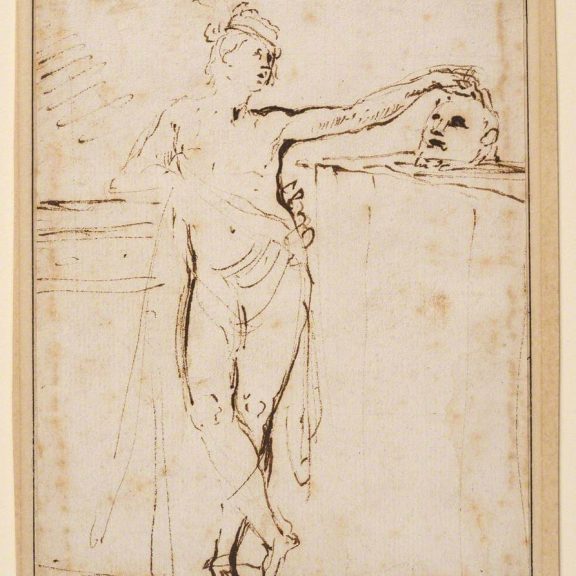
David With the Head of Goliath
Date: about 1620
Object number: P226
Artist: Guido Reni
Reni was a prominent artist of the Bolognese school in Italy, who later became one of the most important painters working in Rome.
This sketch illustrates a scene from the biblical story of David and Goliath. The young shepherd boy David stands next to the severed head of the giant Goliath, after killing him with a single shot from his slingshot.
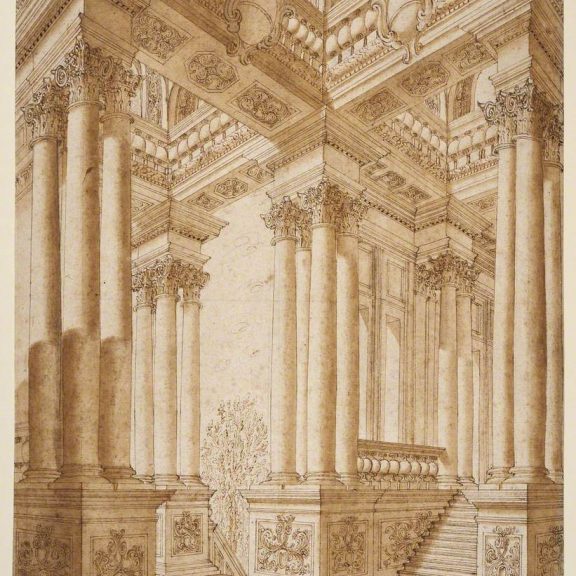
Architectural Fantasy
Date: about 1740
Object number: P984
Artist: School of Giuseppe Galli Bibiena
The Galli Bibiena family were Italian architects and scenic artists. They worked throughout Europe during the late 17th and 18th centuries creating elaborate sets for theatres and events hosted by wealthy patrons.
Because their work was mostly created as temporary decoration, little of it has survived. This complex and beautifully detailed drawing offers a rare glimpse into the splendour and richness of the imaginary worlds created by this family of artists and decorators.
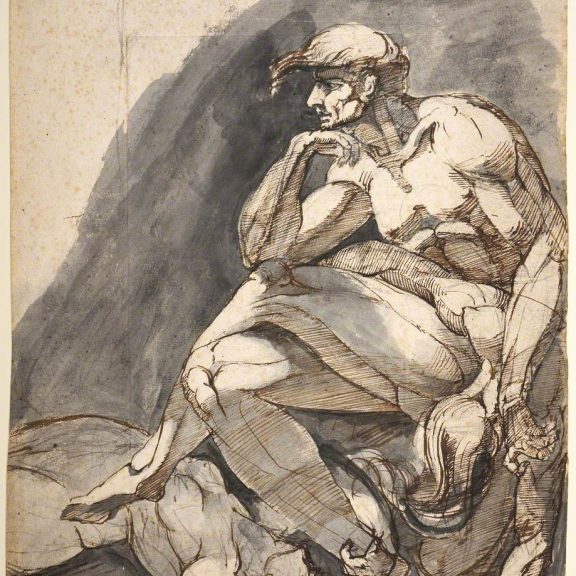
Man with Two Dead Women
Date: about 1772
Object number: P246
Artist: Henry Fuseli
Fuseli was a Swiss painter who lived and worked primarily in Britain. Many of his works deal with supernatural subjects and nightmares. His style influenced many younger artists, including William Blake, whose work is displayed on the right.
This drawing is of a particularly dark subject. It shows a seated man with the limp body of a dead woman draped across his knee. The emphasis on musculature and the unnatural position of the dead woman at his feet adds to the drama of the scene.
The dark wash in the background is a technique often used by Fuseli. It pushes the figures towards the viewer, adding to the sinister atmosphere of the work.
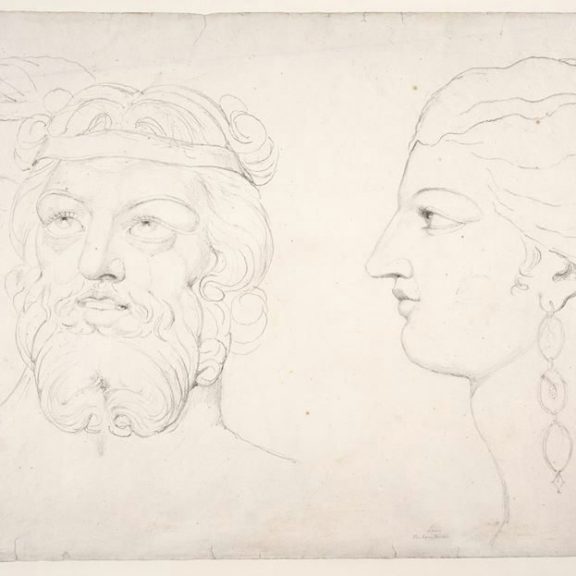
Visionary Heads
Date: 1820
Object number: P44
Artist: William Blake
Blake visited his friend John Varley, a landscape painter, over several nights in 1819. Here, from nine in the evening until the early hours, Blake is said to have sketched visions that appeared before him.
His drawings included long-dead historical figures such as Robert the Bruce and Alexander
the Great and characters of myth and legend including Merlin and Robin Hood. Blake continued to make these visionary drawings over a number of years. Most were gathered together in sketchbooks with inscriptions written by Varley.
The Visionary Heads in this drawing are Greek historical figures – Pindar the poet and Lais, a beautiful courtesan. The fine, delicate lines give the drawings a dream-like quality, the figures appear to hover on the page as if in a trance.
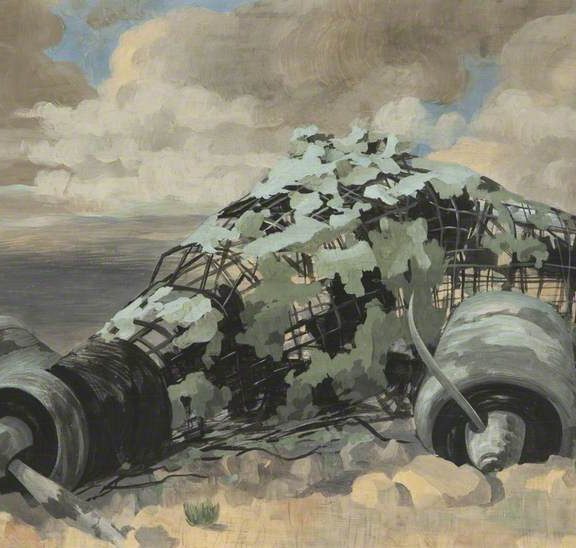
Burnt Out Aeroplane
Date: 1941
Object number: P1111
Artist: John Armstrong
This painting depicts the skeletal remains of a burnt out Italian Savoia-Marchetti SM79 bomber. It was made from a photograph taken after a raid on Castel Benito, an airfield created by the Italian Air Force in Tripoli.
Armstrong was commissioned by the War Artists’ Advisory Committee to make two paintings of crashed aircraft. The other is now at Manchester Art Gallery. Called September 1941, it depicts wrecks of British and German fighter planes on the south-coast.
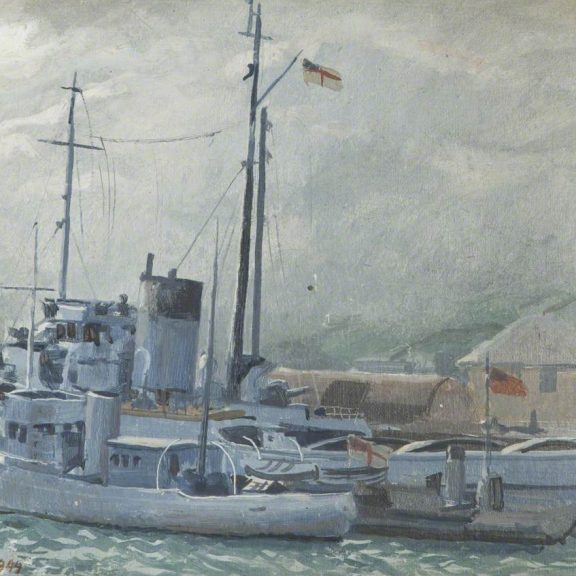
H.M Rescue Tug Samsonia with Water-boat and H.M Yacht Martinetta
Date: 1944
Object number: P1355
Artist: Stephen Bone
At the outbreak of the War, Bone enlisted with a unit at Leamington Spa to work on camouflage designs aimed at concealing important sites like power stations, factories and air fields. He was made a full-time, salaried War Artist in 1943, filling a post vacated by his father Muirhead, who had been the very first War Artist appointed.
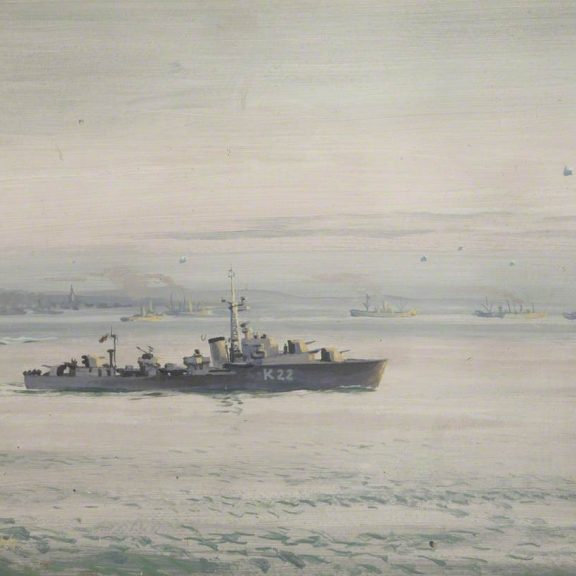
Destroyer Off the Normandy Beaches
Date: 1944
Object number: P1109
Artist: Stephen Bone
Bone specialised in Admiralty subjects, travelling across the country painting Royal Navy bases, ships and submarines. In 1944 he witnessed the Normandy landings, and recorded Naval activity like this Destroyer. The warship used torpedoes and anti-aircraft guns to protected merchant-ship convoys and battle fleets from attack.
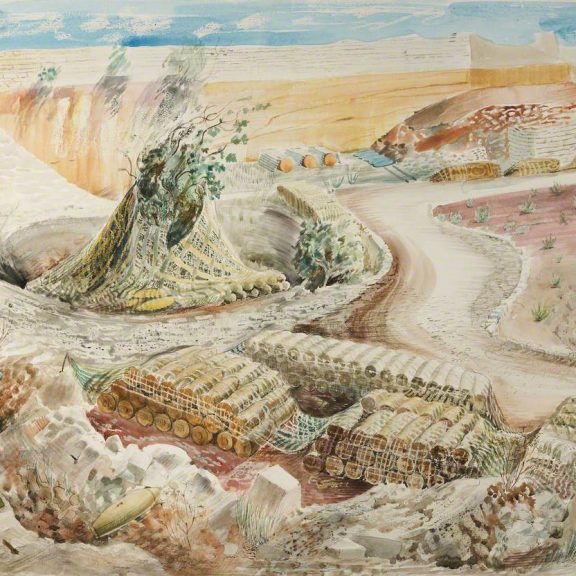
Malta, RAF Bomb Dump
Date: 1943
Object number: P1114
Artist: Leslie Cole
The Siege of Malta was a military campaign to maintain control of the island, which was an important British colony and trade route to North Africa, India, and the Far East.
Malta was one of the most heavily bombed places during the Second World War. The RAF and Royal Navy fought against German and Italian forces who attacked the island’s ports, towns and supply ships.
Cole arrived in Malta in May 1943. He observed the end of the siege, and recorded military sites like this bomb store. He also made paintings depicting the hardship and cruel conditions endured by Malta’s civilian population.
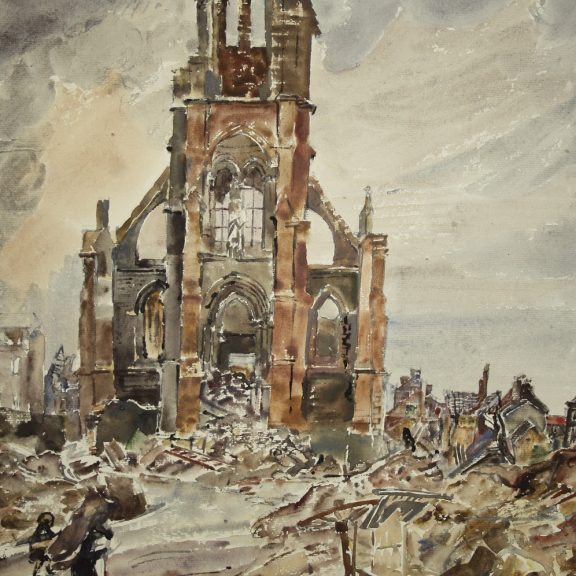
Church of St. Pierre, Boulogne
Date: 1944
Object number: P1112
Artist: Thomas Hennell
In June 1944, Hennell was sent to Portsmouth to record preparations for D-Day, the Allied invasion of Normandy. Soon after, he was across the English Channel making watercolour sketches of troops on the Normandy beaches.
The coastal town of Boulogne was badly bombed by the RAF during the invasion. In August, Hitler declared the town a “fortress”, but in September the town was liberated by the Canadian Army. This painting of the town’s church in ruins is a poignant reminder of the suffering and destruction endured by so many during the Second World War.
Hennell was sent to record the war effort in India and Burma (now Myanmar). He survived the war but disappeared in Java in 1945. Reports suggest that he was captured and killed during the Indonesian War of Independence, but this was never confirmed.
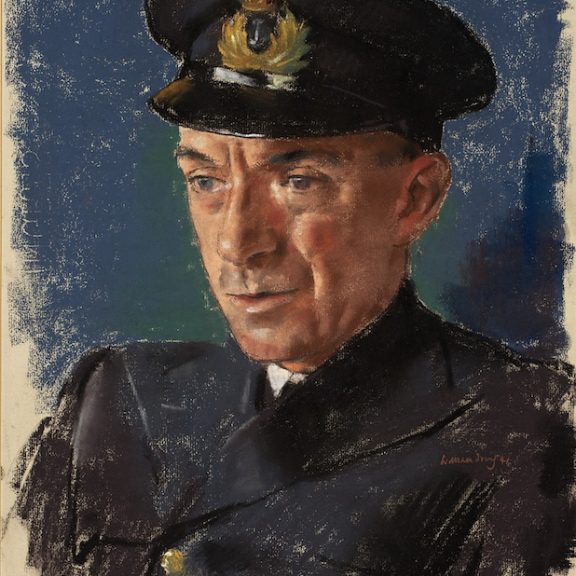
Lieutenant (E) R W Daish RNR Chief Engineer
Date: 1941
Object number: P1110
Artist: William Dring
This is a portrait of Ralph William Daish, the Chief Engineer of HMS Lorna Doone. A paddle steamer requisitioned by the Admiralty as a minesweeper in 1939. The Admiralty was the government department responsible for the command of the Royal Navy.
Dring was born in Streatham, London. He graduated at the Slade School of Art, before teaching drawing at Southampton School of Art. Dring was appointed as an official War Artist to the Admiralty in 1942.
He travelled widely across Britain, making portraits of Naval officers. Working in soft pastel allowed Dring to get colour and detail onto the paper quickly. He took no longer than an hour to finish each portrait.
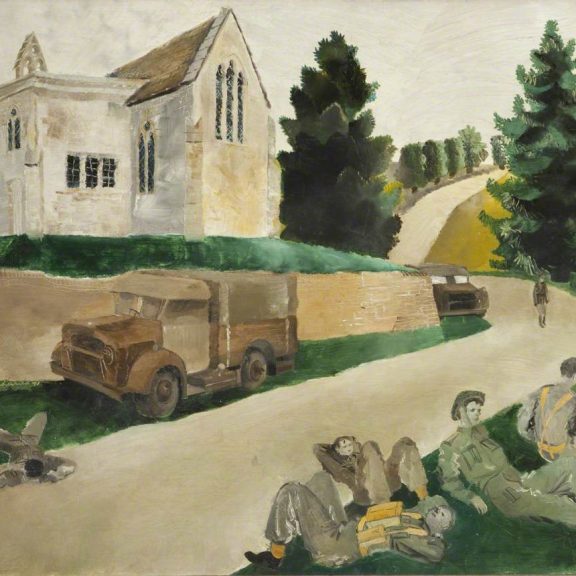
The Minute Halt
Date: 1941
Object number: 2007.118.1
Artist: Albert Richards
Richards was born in Liverpool, his father George was a World War One veteran. He studied at the Royal College of Art in London for three months before being conscripted into the Army in 1940.
After parachute training and promotion to Captain, he parachuted into Normandy on D-Day. Richards was killed in action on the night of the 5 March 1945, when he drove his jeep into an unmarked mine field in Holland. He was planning to make drawings of the retreating German troops. He told his friend that he was going to paint, what for him, was to be ‘the greatest picture of the war’. He was 25 years old.
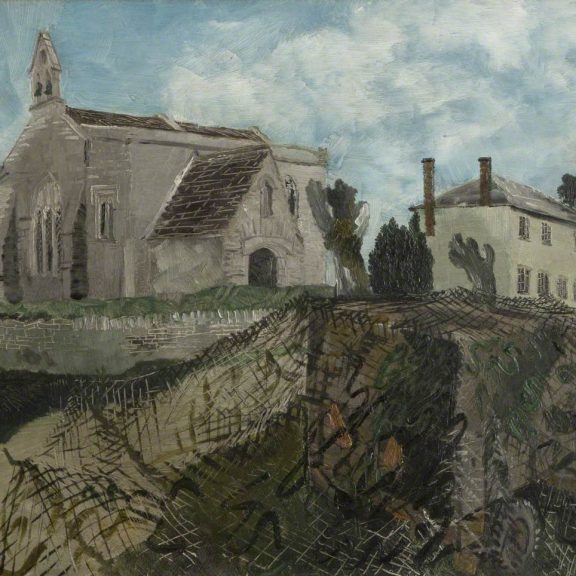
Inglesham Church and Rectory
Date: 1941
Object number: 2007.118.2
Artist: Albert Richards
Richards served with the Royal Engineers, and in 1941 was billeted at Inglesham, a small village in Wiltshire. This painting, and the one to the right, show the beautiful 13th century church of St John the Baptist at Inglesham.
This smaller painting includes the rectory and nearby Church Farm. In the foreground an Army truck is hidden under camouflage netting. It is thought to be a study for the larger painting, The Minute Halt, which includes soldiers resting at the side of the road. Both paintings helped to get Richards’ work recognised by the War Artists’ Advisory Committee. He later gave them to his mother, signing them Bertie, as he was known by his family.
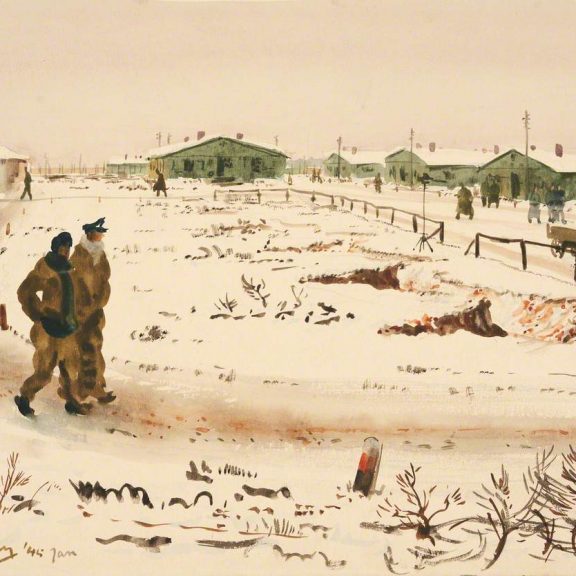
Marlag ‘O’ in Winter
Date: 1945
Object number: P1353
Artist: John Worsley
At the start of the Second World War, Worsley joined the Royal Navy. His drawings of life at sea caught the attention of the War Artists’ Advisory Committee, and he was appointed as a full-time war artist.
In 1943 Worsley was captured by the Germans and detained at Marlag ‘O’, a prisoner-of-war camp. He continued to paint at the camp, documenting prison life using materials provided by the Red Cross. These parcels contained food and other supplies, reminding the men that they had not been forgotten. The tin cans were re-used for a variety of purposes, in Worsley’s case to safely carry his pictures to freedom in April 1945.
His skills as an artist were employed to forge identity papers. He also made a life-sized mannequin called Albert during an ingenious escape attempt, which in 1953 was made into a film, Albert R.N.
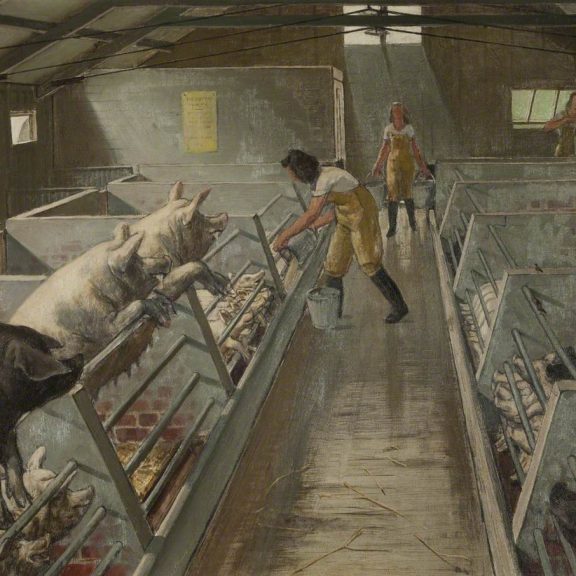
Women’s Land Army at Work
Date: 1940
Object number: P1113
Artist: James Bateman
The Women’s Land Army worked in agriculture, replacing male farm workers who were called up for military service. It was created during the First World War but was reformed at the beginning of the Second World War. By 1944 had over 80,000 members.
Known as ‘Land Girls’, they were critical to Britain’s food production, providing much needed help for farmers across the country.
Bateman came from a farming family in Kendal. He was best known for his paintings of country life and would have been familiar with scenes like this pig shed. The War Artists’ Advisory Committee commissioned artists to document all kinds of war work, at home and overseas.
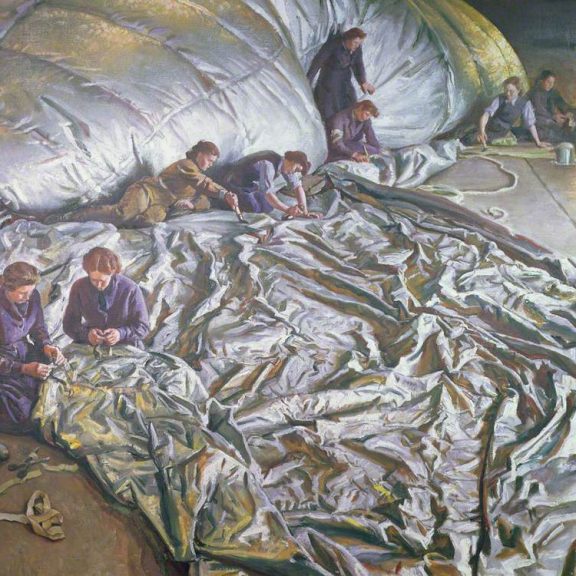
In for Repairs
Date: 1942
Object number: P1116
Artist: Laura Knight
Born Laura Johnson in Long Eaton, Derbyshire, Knight was first given art lessons by her mother before attending Nottingham School of Art at the age of thirteen. In 1903 she married fellow art student Harold Knight and they travelled to Staithes in Yorkshire, before moving to Cornwall.
In 1929, she was created a Dame Commander of the British Empire (DBE). Her work focussed particularly on the circus, the ballet and the theatre. She also painted a number of works depicting Gypsies.
Knight’s painting shows members of the Women’s Auxiliary Air Force (WAAF) repairing a barrage balloon at RAF Wythall, near Birmingham. A quarter of a million women served in the WAAF during the Second World War. They worked in over 110 trades, supporting operations around the world.
As an Official War Artist, Knight was especially interested in representing women who excelled in roles traditionally carried out by men. Her long and successful career paved the way for many female artists.
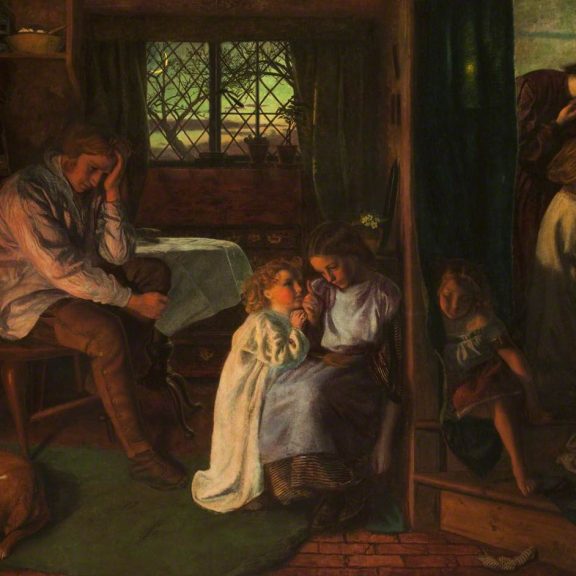
Bed-time
Date: 1862
Object number: P1486
Artist: Arthur Hughes
A father sits looking thoughtful as his children slowly make their way to bed. One girl raises her finger to silence chatter while another child prays. The artist and his own children acted as models. But, there is debate whether the taller figure on the right is his wife Tryphena or his eldest daughter.
Hughes was part of the wider Pre-Raphaelite circle of artists, working with Rossetti, Morris and Burne-Jones occasionally.
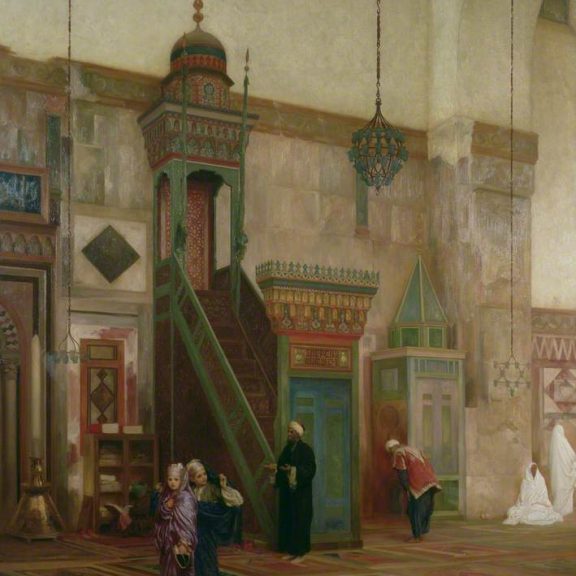
Interior of the Grand Mosque at Damascus
Date: about 1874
Object number: P366
Artist: Lord Frederic Leighton RA
Leighton greatly admired Islamic culture, yet made an error in this painting of the Umayyad Mosque’s prayer hall. Glimpsed on the far left is the mihra, a niche which points worshippers towards Mecca. Instead, Leighton makes the pulpit or minbar the central focus as it is in a Protestant church.
The Mosque was built during the early 700s but suffered terrible fire damage in 1893.
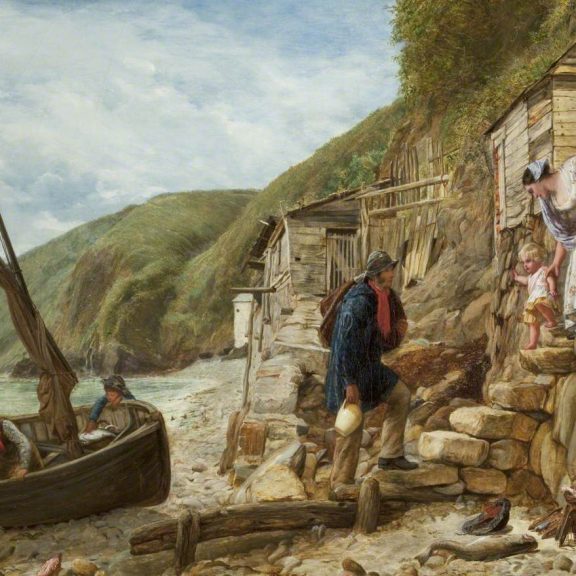
Welcome, Bonny Boat! The Fisherman’s Return at Clovelly, North Devon
Date: 1856
Object number: P298
Artist: James Clark Hook RA
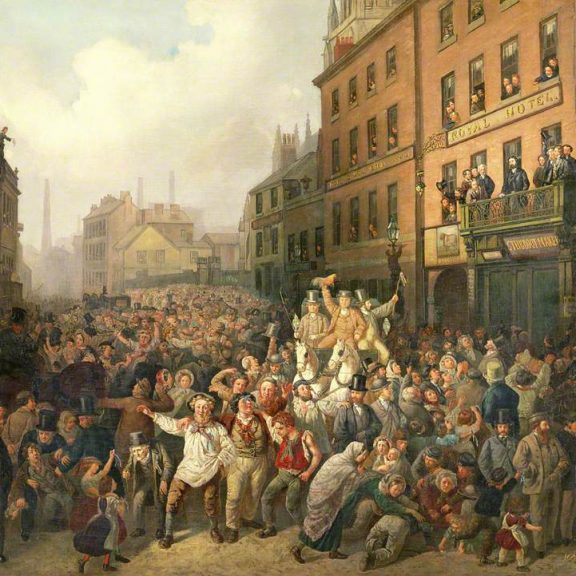
The Preston By-Election of 1862
Date: 1862
Object number: P1690
Artist: Vladimir Ossipovitch Sherwood
Sir Thomas Hesketh, a Conservative, has won the election and stands on the Bull and Royal balcony. A cockerel, the Conservative mascot, is held aloft in victory, but it was claimed that voters were bribed. A man in a smock puts money in his pocket and, at the front, people scrabble for tossed coins.
Sherwood, a Russian, lived Blackburn for four years at the invitation of a local merchant.
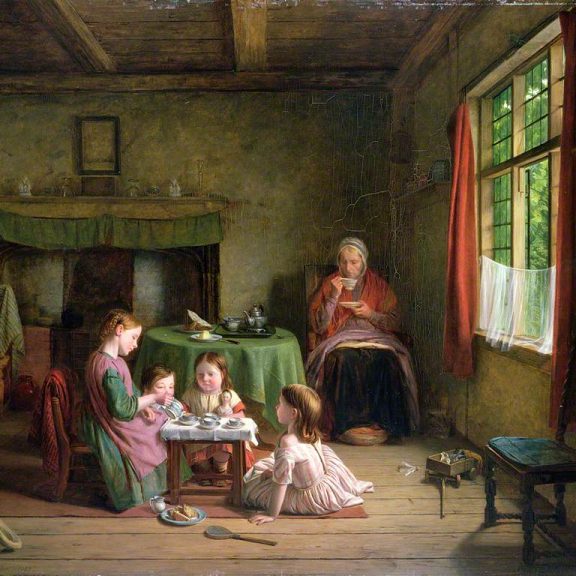
A Tea Party
Date: 1862
Object number: P672
Artist: Thomas Webster RA
The children’s tea party, with its matching crockery and bright, white cloth, contrasts with their rather dreary surroundings. In the corner, an elderly minder quietly sips her own tea.
Webster specialised in gentle, humorous scenes of everyday life, often featuring children. He lived in the village of Cranbrook in Kent alongside other artists who painted in a similar style. They are known as ‘The Cranbrook Colony’.
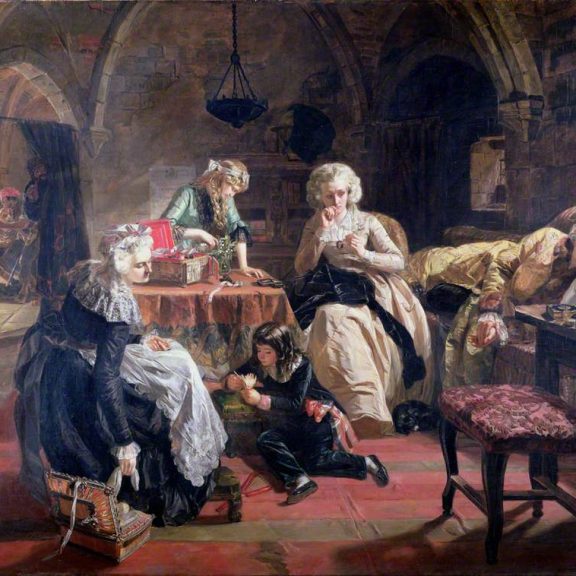
The Royal Family of France in the Prison of the Temple
Date: 1851
Object number: P667
Artist: Edward M. Ward RA
Included in the painting are: Louis XVI, Queen Marie Antoinette, the Dauphin, Dauphiness, and Madam Elizabeth, the King’s Sister
During the French Revolution the Royal family was imprisoned in the Temple, a medieval fortress in Paris. Trying to keep up appearances, Marie Antoinette mends the King’s coat whilst he sleeps. The children and their aunt keep occupied while, through the doorway, jailers play cards and another peers at the family.
The King and Queen were executed in 1793. When this painting was shown in France it made people cry.
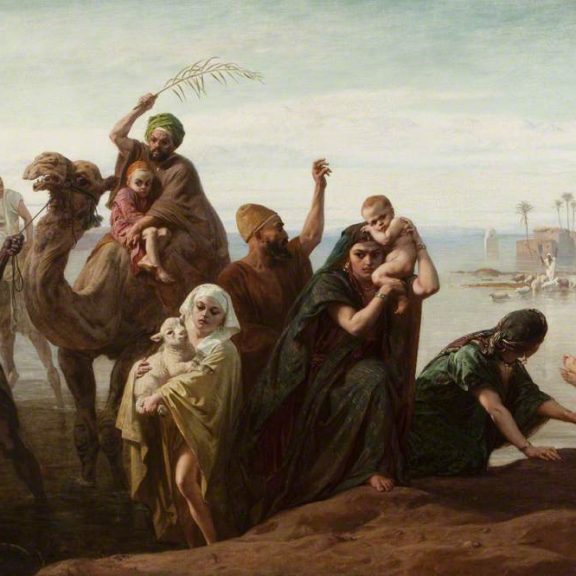
The Sudden Rising of the Nile
Date: 1865
Object number: P257
Artist: Frederick Goodall
The River Nile burst its banks annually making villagers flee from the flooding. Eventually, the waters subsided and everybody could return home. Since the 1970s, the Aswan High Dam has helped to prevent these unpredictable surges.
Goodall travelled to Egypt in 1858 and 1870-1. A major work like this was based on sketches made in Egypt but painted in Britain. Goodall collected Egyptian artefacts to use as props back home, even sheep which he kept in his garden.
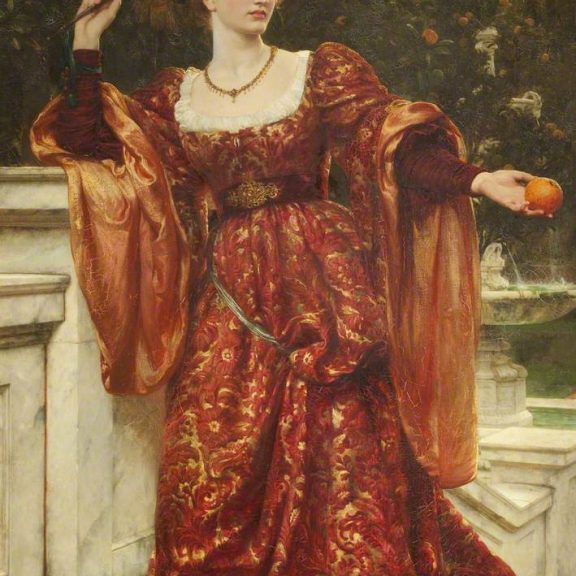
Hesperia
Date: 1887
Object number: P819
Artist: Sir Frank Dicksee RA
Hesperia is one of three sisters from Greek mythology called the Hesperides. They tended a beautiful garden where golden apples grew which gave immortality when eaten. Although she is supposed to be guarding them, Hesperia reaches out to steal an apple for herself. She is sometimes known as Erytheia, ‘the red one’.
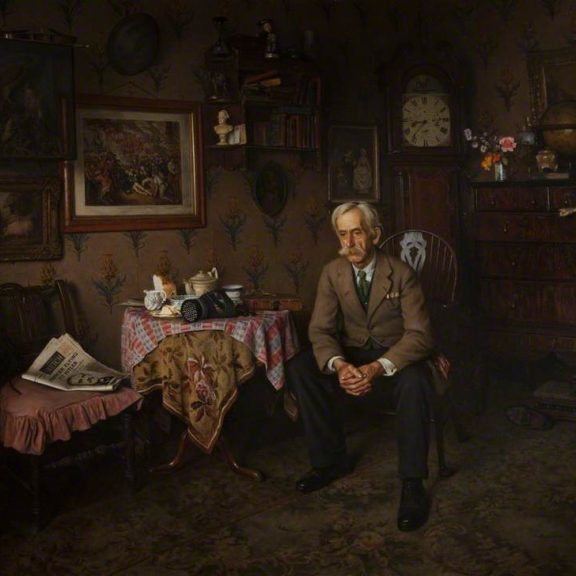
Why War?
Date: 1938
Object number: P845
Artist: Charles Spencelayh
Having fought in ‘the war to end all wars’, this First World War veteran sadly contemplates the onset of the Second World War. Near him lies a new gas mask from Lewisham Council and a newspaper covering Chamberlain’s abortive mission to make peace with Hitler.
Spencelayh’s training as a miniaturist allowed him to build up a story of visual clues in painstaking detail.
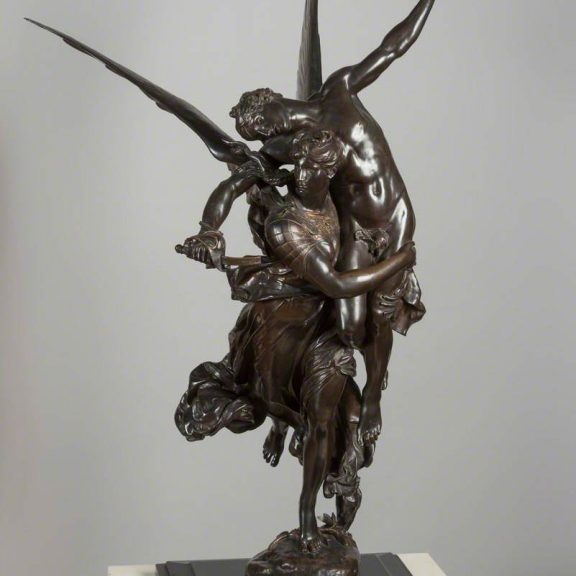
Gloria Victis
Date: about 1880
Object number: S58
Artist: Antonin Mercié
The title of this sculpture is in Latin, it means ‘Glory to the Vanquished’. Mercié made the original in 1874 in response to the Franco-Prussian War of 1870, which France lost. This version is one of a number of casts made in the 1880s.
It shows a fallen warrior being carried to heaven by a winged female figure. Mercié probably drew his inspiration from the winged Greek goddess of victory, Nike. Here Nike has been combined with the traditional image of an angel creating a sculpture with both Classical and Christian elements.
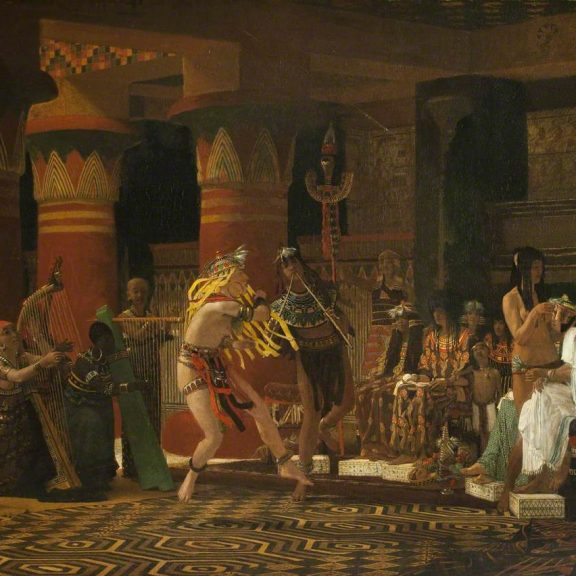
3000 Years Ago
Date: 1863
Object number: P8
Artist: Lawrence Alma-Tadema
This scene depicts a Royal Court, where a Nubian ambassador – dressed in white – is entertained by a dancer and musicians. To his right sits the host, a priest called Phtames, a scribe to the god Ptah at Memphis.
The subject of this painting was suggested to the artist by a wall painting he saw during a visit to the British Museum in 1862.
Many of Alma-Tadema’s paintings offer a glimpse into the ancient past. He used historical sources and the most up-to-date archaeological findings when researching his paintings. The harp in the painting is drawn from an example he saw at the Louvre, in Paris, and the chairs from the British Museum.
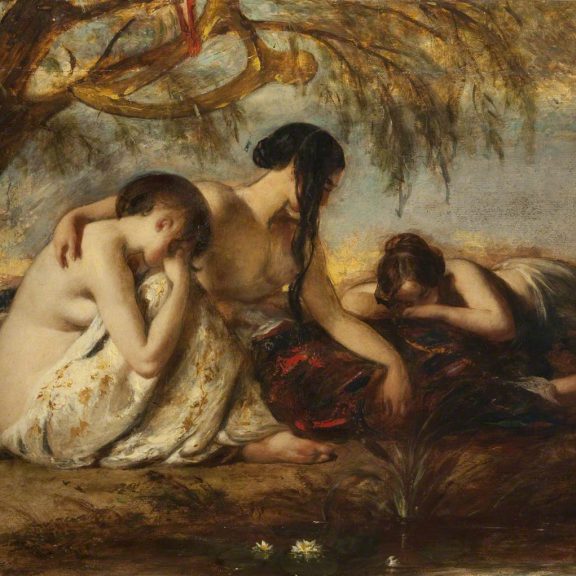
By the Waters of Babylon we Sat Down and Wept
Date: about 1848
Object number: P218
Artist: William Etty
Taken from the 137th psalm, this biblical scene depicts a group of Jewish captives mourning their exile from Jerusalem following the Babylonian conquest of the city.
Born in York, Etty was able to go to London and enter the Royal Academy Schools due to the financial support of his uncle. Inspired by artists like Rubens and Titian he specialised in painting nudes, and in doing so became one of the most controversial artists of the Victorian era.
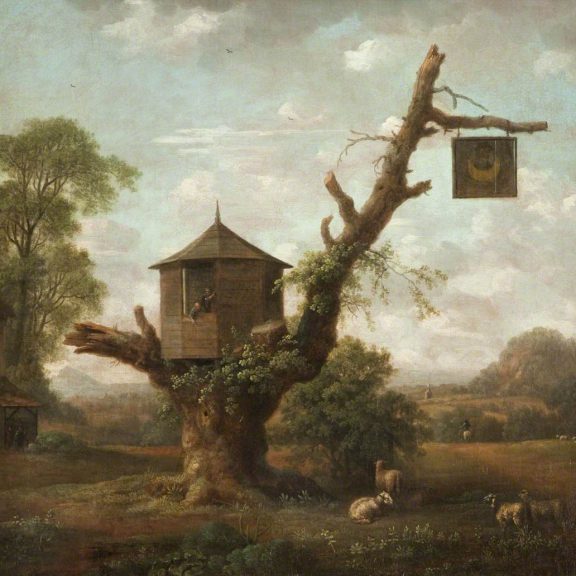
The ‘Man in the Moon’ Inn
Date: about 1785
Object number: P1405
Artist: Anthony Devis
Did this remarkable pub in a tree really exist? We are not sure. Devis may have copied the scene from a Dutch painting. The behaviour of some figures is bawdier than Devis usually depicted and more in keeping with the Dutch style.
Preston-born Devis was half-brother to the portrait painter Arthur. Anthony was a very successful landscape painter who settled in Surrey in 1780. If the pub did exist, it may have been there.
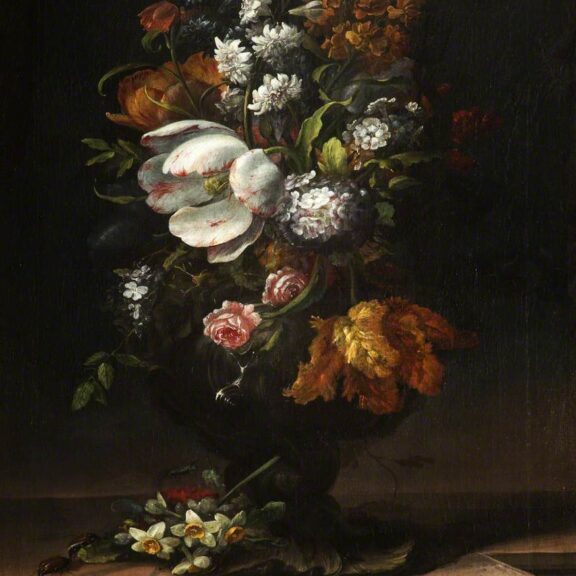
Summer Flowers
Date: 1695
Object number: P828
Artist: Rachel Ruysch or a follower
Ruysch was one of the most celebrated artists of the Dutch Golden Age and appointed court painter. Her scientific knowledge of flowers was learnt from her father, a professor of botany. This painting is typical of Ruysch’s meticulous detail set against a dark background. However, she only completed about 100 paintings herself and her work was often copied.
This remarkable artist also had 10 children with her husband, portrait painter Juriaen Pool.
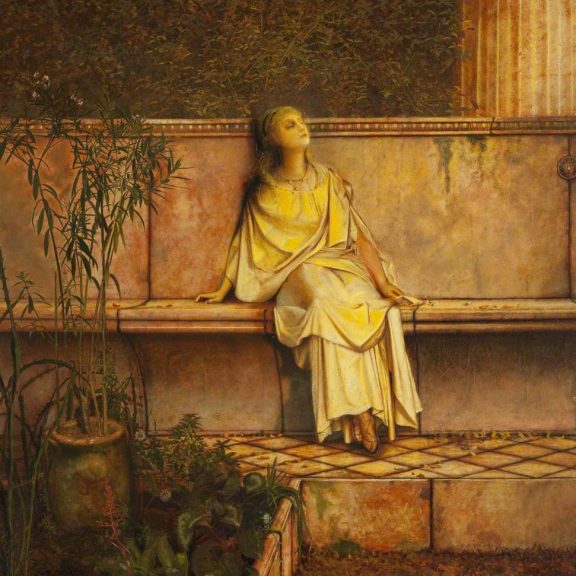
Golden Visions
Date: 1870
Object number: P269
Artist: John Atkinson Grimshaw
John Atkinson Grimshaw was born in Leeds in 1836. He had no formal art education, but most likely learned to paint through visiting galleries. He had his first exhibition in Leeds in 1862.
Grimshaw began by painting nature scenes but his repertoire soon expanded to cover fashionable women, scenes from ancient Greece and Rome and townscapes. However, he is most famous for his moonlight scenes.
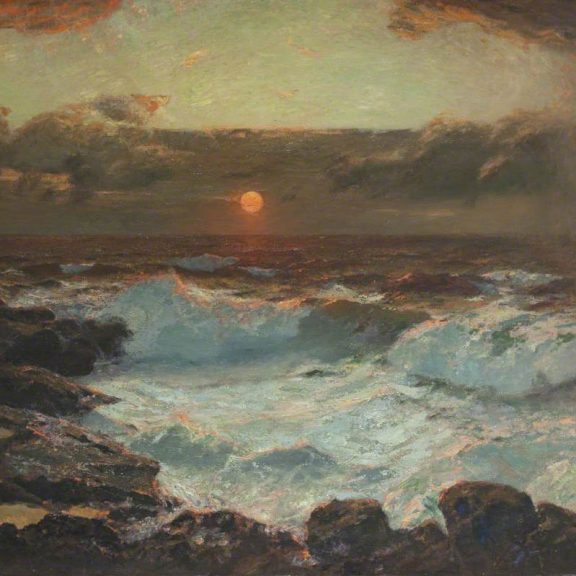
Sunset at Land’s End
Date: 1910
Object number: P448
Artist: Julius Olsson
Olsson is one of only a few artists who specialised in pure sea painting, in particular twilight and moonlight scenes. He was born in London but moved to St Ives, Cornwall in 1888. Olsson described sea painting as one of the most difficult subjects for a painter.
‘For one whose heart draws him to the sea, in the first place must have an exceptionally retentive memory, and be able to grasp in a few moments the effect of the ever-changing movements of the sea and sky; he must have a delicate and subtle sense of colour, and have the ability to place the main features of his impression on the subject of the subject on the canvas with a few strokes of the brush, and beside this, he must be prepared to face a brave fight with the elements, which will frequently be against him.’
Julius Olsson, 1934
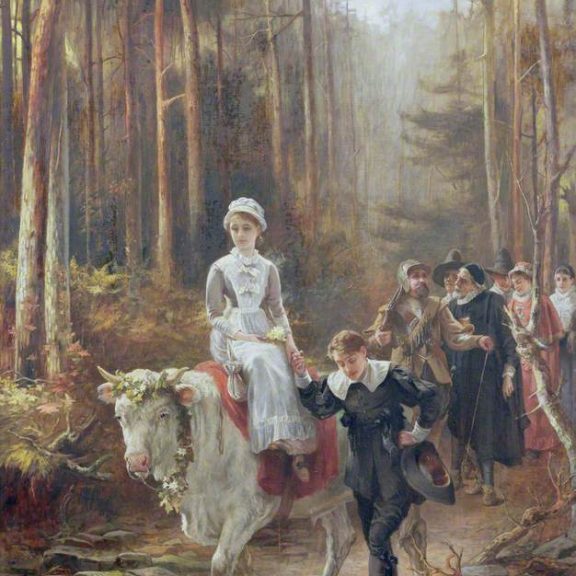
Priscilla – the Courtship of Miles Standish
Date: 1885
Object number: P468
Artist: Laslett John Pott
Miles Standish (1584-1686) was the Captain of the settlement of Plymouth Colony in what is now Massachusetts, USA. The story depicted here appears in a long poem of 1858 written by the American poet, Henry Wadsworth Longfellow (1807-1882).
According to Longfellow, Standish asks his friend, John Alden, to woo Priscilla on his behalf. Alden, although in love with the girl, agrees out of duty to his friend. Priscilla, unimpressed that he will not pay court for himself, rejects Standish. Furious at this and believing himself to have been betrayed by Alden, he leaves for war against the ‘Indians’. In his absence, Alden and Priscilla fall in love and, hearing of Standish’s death, they decide to marry. This news proves to be false, however, and the Captain returns to attend the wedding and beg forgiveness for his anger. The three are then reunited as friends. The villagers crowd round Standish, overjoyed at his safe return and eager to hear of his adventures. Meanwhile, Alden leads his bride from the ceremony through the Massachusetts woods, riding upon his ‘snow–white bull’.
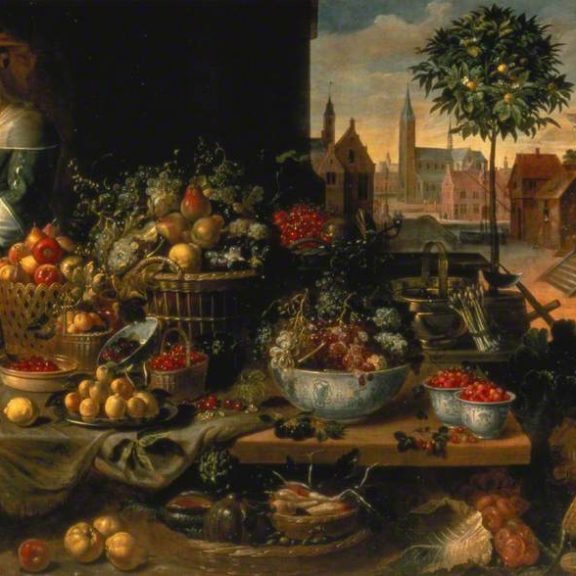
A Fruit Stall
Date: 1640
Object number: P1598
Artist: a follower of Frans Snyders
Frans Snyders was a Flemish artist, born in the city of Antwerp, now in modern Belgium. He specialised in still-life paintings of fruit and game, occasionally working in collaboration with other artists.
Around 1615 Sydners was commissioned to paint a group of paintings known as The Four Markets – which now hand in the Hermitage Museum in St. Petersburg. Snyders’ Fruit Stall resembles the Harris’s closely and, for many years, our picture was thought to be a copy. However, the differences are significant enough for it now to be considered an independent work by an artist influenced by Snyders, possibly even trained within his workshop. It certainly dates from well after 1615, the clothing of the two women suggesting the 1640s.
The prominence of the building on the right (which is most likelt a guild hall for butchers) suggests that this painting may have been commissioned for that building.
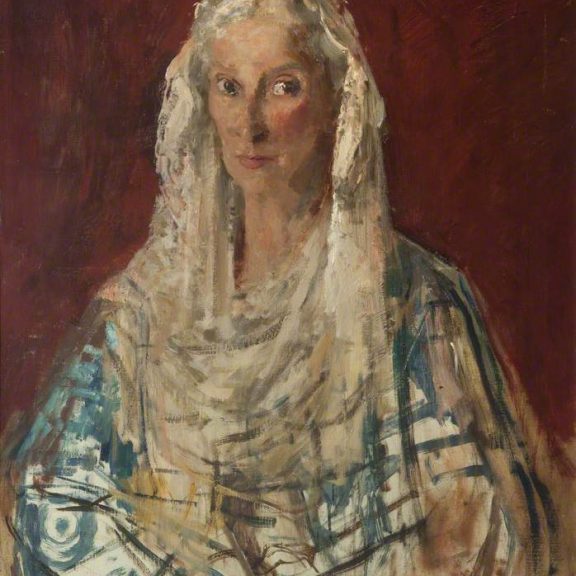
Dorelia
Date: 1959
Object number: P1616
Artist: Augustus John
This is a portrait of the artist’s second wife, Dorothy McNeill, known as Dorelia, or Dodo. The couple met in 1903 and began a passionate affair in which Dorelia lived with both John and his first wife, Ida Nettleship, whom he had married in 1901. This ménage à trois continued until Ida’s death in 1907. Dorelia and John later married, living together, despite his numerous affairs, until the painter’s death in 1961.
A brilliant draughtsman, John worked mainly as a portraitist, including the Queen and Winston Churchill amongst his sitters. Despite his connections with society, he and his family lived a bohemian lifestyle, rather like early hippies or New-Agers, wearing gypsy style clothing, even living for a time in a gypsy caravan. His interest in gypsies was serious and he sought them out wherever he went. He campaigned for gypsy and traveller rites and was elected president of the Gypsy Lore Society in 1936.
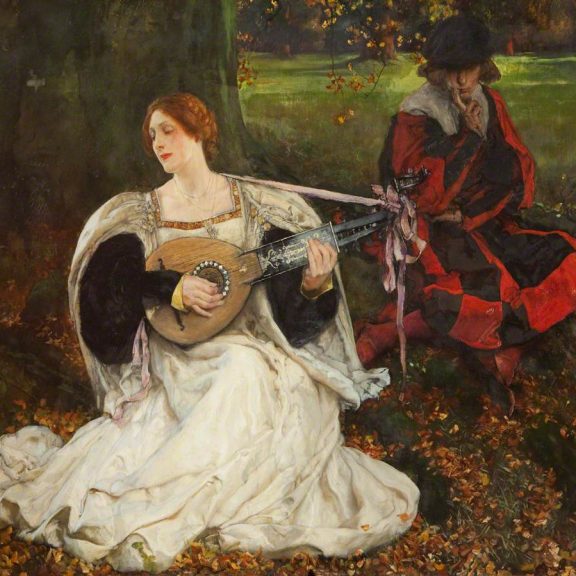
Fair is My Love
Date: 1900
Object number: P1
Artist: Edwin Austen Abbey
Edwin Austen Abbey was an illustrator and painter. He was born in Philadelphia, on 1 April 1852. At the age of fourteen he took up drawing lessons. From around 1871, he prepared drawings for Harper’s Weekly and Harper’s Monthly, as well as for books such as Charles Dickens’ Christmas Stories of 1876.
His work was inspired largely by that of the English illustrators of the 1860s. He developed a pen and ink style characterised by compositions that were created to resemble architecture; glittering light effects; attention to detail; and an insight into human emotions.
In December 1878, Harper’s magazine arranged for Abbey to travel to England in order to absorb its ambience directly. He planned to stay for a year, but remained in England for most of the rest of his life.
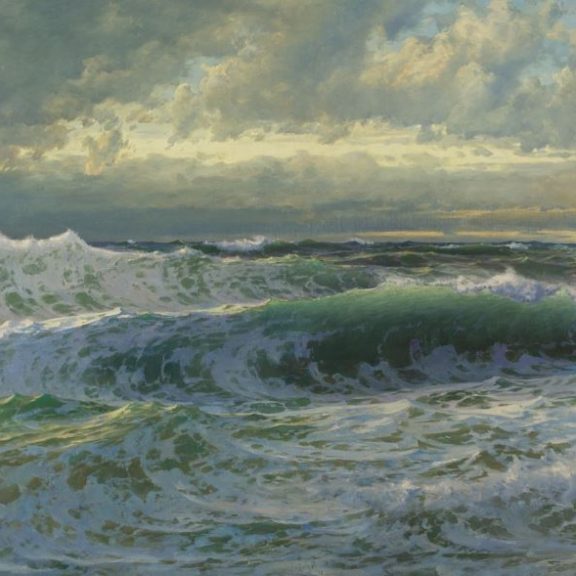
After A Gale
Date: 1903
Object number: P484
Artist: William Trost Richards
This oil on canvas is titled After A Gale, it was painted by William Trost Richards (1833-1905) in 1903 and purchased by the museum in the same year. Trost was an American artist from Philadelphia who was influenced by John Ruskin, and the Pre-Raphaelites. In the 1870s he began to devote his attention to marine painting and travelled to Europe in search of dramatic coastal scenery – including the UK, France and Norway.
The painting was selected by the Harris LGBTQ group to feature in the LGBT+ History Month Trail in 2019 and 2020. Phil, a member of the group, wrote the following interpretation inspired by their response to the painting:
“I have chosen this painting because it is one of the finest in the Harris collection. For me it is also an unwitting symbol of the unwritten history of gay culture and the sea. Churchill famously referred to the Navy as ‘nothing but rum, sodomy and the lash’ – even though homosexuality was illegal in the military until 2000.
Pirate ships were another male dominated, maritime world. Before the Reformation, people attracted to others of their own gender might have joined a monastery or nunnery. From the 1550s men who didn’t fit in might have been attracted by piracy. It was a masculine world in which same sex relationships were tolerated and celebrated.”
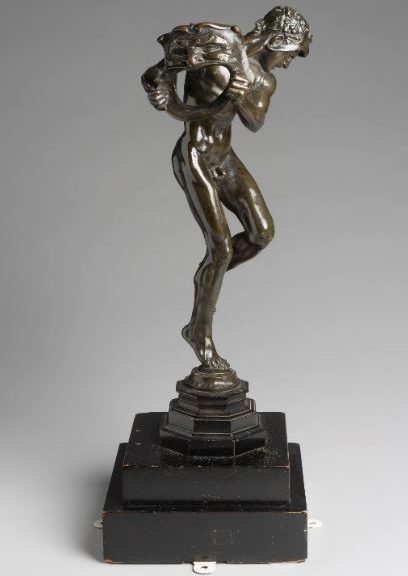
Comedy and Tragedy
Date: 1890s
Object number: S26
Artist: Sir Alfred Gilbert
This bronze sculpture by Sir Alfred Gilbert is from the 1890s. The Latin subtitle to this work ‘Sic Vita’ means ‘Thus is life’. Gilbert said the figure in the sculpture represents a prop-boy from Greek theatre carrying the mask of Comedy: ‘He is stung by a bee – a symbol of love. He turns and his face becomes tragic.” It was purchased by the museum in 1905.
The sculpture was selected by the Harris LGBTQ group to feature in the LGBT+ History Month Trail in 2019 and 2020. Cobie, a member of the group, wrote the following interpretation inspired by their response to the sculpture:
“For me this sculpture represents the duality of the queer experience. The naked body seems closed off – head and legs pulling together displaying a shy nature. Despite being so exposed the body also appears recoiling from the mask. At the same time the mask is held up like a shield – an almost crazed visage suggesting a more outgoing nature masking the vulnerability underneath.
Many LGBTQ people will be familiar with the notion of hiding their true selves out of fear, shame and society’s pressures. How many of us live up to a stereotype to fit in with what the world expects of us, whilst no one sees the real person underneath?”
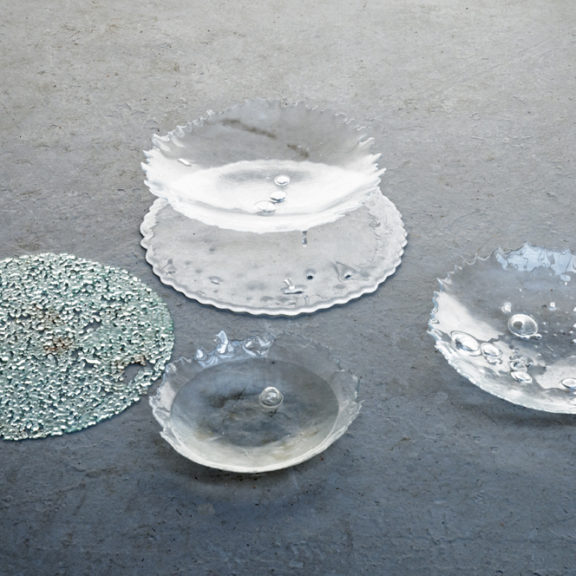
Manchester (09/08/2011)
Date: 2012
Object number: 2015.379
Artist: Ana Rosa Hopkins
This art work is made from broken glass collected by Manchester-based artist Ana Rosa Hopkins after riots in the city in August 2011. On 4 August 2011 29-year old Mark Duggan was shot by police in Tottenham, which triggered violent protests in London. Between 8 and 11 August there were riots in many other UK cities – including Birmingham, Leeds, Liverpool and Manchester. Ana Rosa Hopkins collected some of the broken glass from the Manchester riot and turned it into this art work. You can see this and other examples of historic and contemporary glasswork in the Harris collection.
Photograph: © Alan Sams
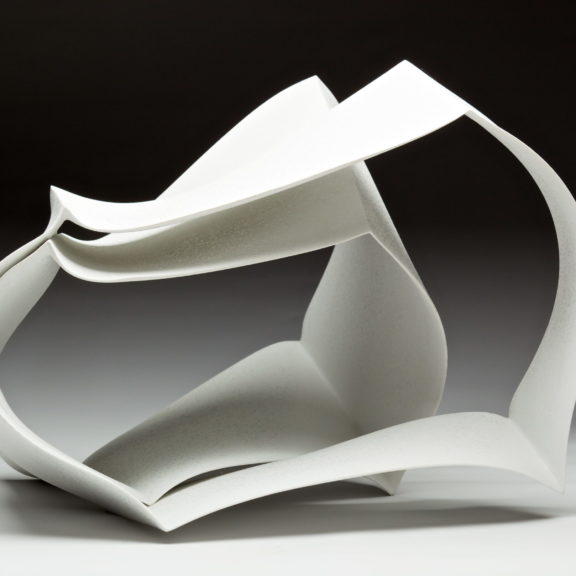
NS-02 Forms in Succession
Date: 2010
Object number: 2013.21
Artist: Shigekazu Nagae
This ceramic can be displayed from any angle: it doesn’t have a front, back, top or bottom. It is made by melting two slip-cast porcelain rectangles together in the kiln. The intensity of heat warps the rectangles into these two interlocking shapes. This ceramic is part of the Harris’s ongoing collection of contemporary ceramic practice.
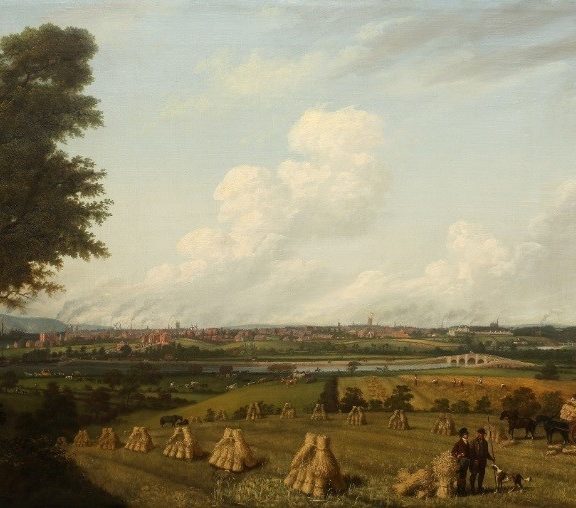
View of Penwortham from Preston
Date: c.1820
Object number: PRSMG: P1618
Artist: Artist
The sunny harvest scene in the foreground is a picture of rural life as it had been for centuries. Across the Ribble and Penwortham Bridge looms the darker atmosphere of industrial Preston, with its rapidly expanding streets of mills and houses.
In the early 19th century, farming was being relocated from the town centre to the green spaces outside its boundaries. The desperate need to provide housing for the rapidly expanding population meant that many of the narrow garden plots and town fields, used for centuries to grow crops, were now packed with dangerous, cramped and unsanitary houses.
Windmills are visible in the distance – Preston was an important corn-milling centre at this time – but smoking chimneys now dominate the skyline
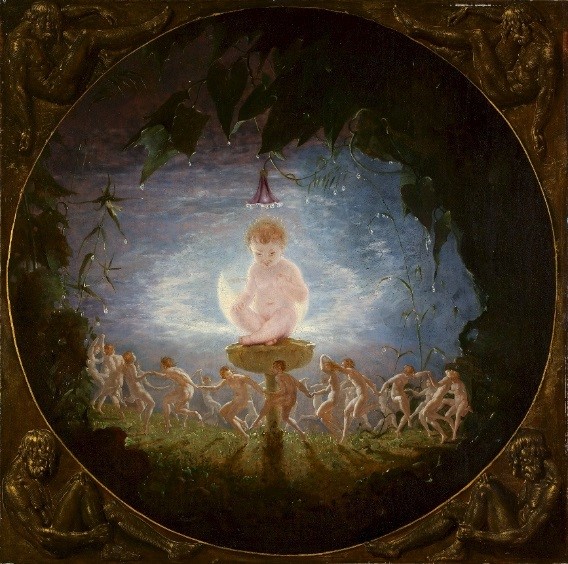
Puck
Date: 1841
Object number: PRSMG: 2011.88
Artist: Richard Dadd
Puck was painted by Richard Dadd, the infamous Victorian artist best know for his ‘fairy paintings’. Puck is a character from Shakespeare’s play A Midsummer Night’s Dream. The painting once belonged to Preston solicitor Thomas Birchall. After many years the painting has returned to Preston and is now part of the Harris’ permanent collection. This is an oil painting on canvas.
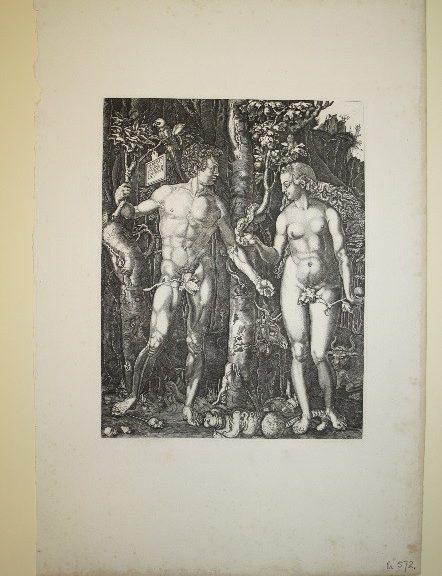
Adam and Eve (the fall of Man)
Date: Unknown
Object number: PR275
Artist: Albrecht Durer Engraver. Johannes Ladenspelder
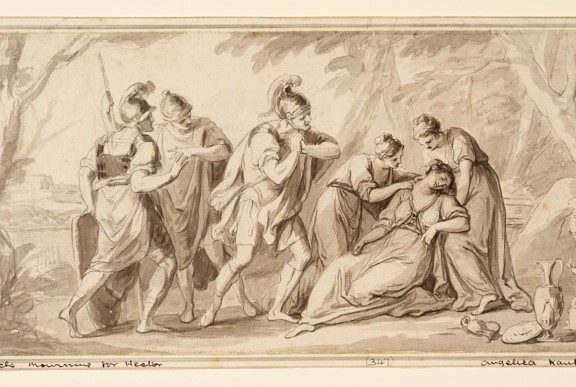
Andromache Fainting at the Unexpected Sight of Aeneas on his Arrival at Epirus
Date: 1775
Object number: P347
Artist: Angelica Kauffmann, 1741-1807
This drawing by Angelica Kauffman is a study for a painting commissioned by the Earl of Derby for his London home in 1775. Based on a story in the Aeneid, an epic poem written by Virgil between 29 and 19BC about the Trojan Wars, the scene depicts Andromache who has been invoking the spirit of her husband Hector. Aeneas, who she believes might be a messenger from the dead, appears and confirms that Hector has been killed and Andromache collapses in grief.
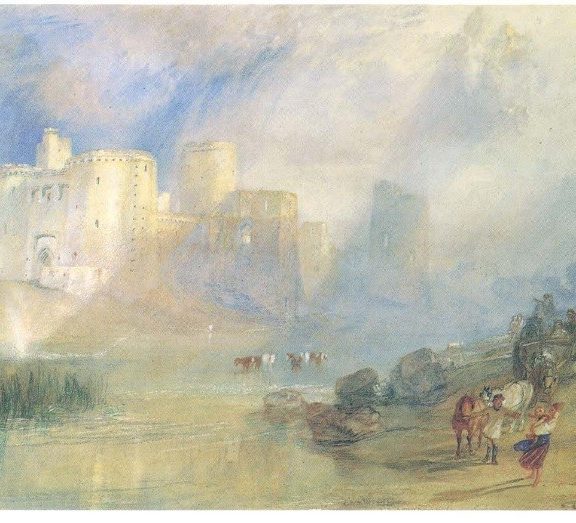
Kidwelly Castle, South Wales
Date: 1835
Artist: JMW Turner, 1775-1851
The Harris’ collection of watercolours includes paintings by JMW Turner, David Cox, Arthur Rackham, Helen Allingham, and Laura Knight.
Kidwelly Castle has occupied its commanding position above the River Gwendreath in South Wales since the 12th century. Turner visited Kidwelly during his 1795 tour of Wales and returned to the subject in 1835 for a series of Picturesque Views in England and Wales. In this atmospheric painting the gatehouse glows in bright sunlight while the rest of the castle emerges from a swirling river mist.
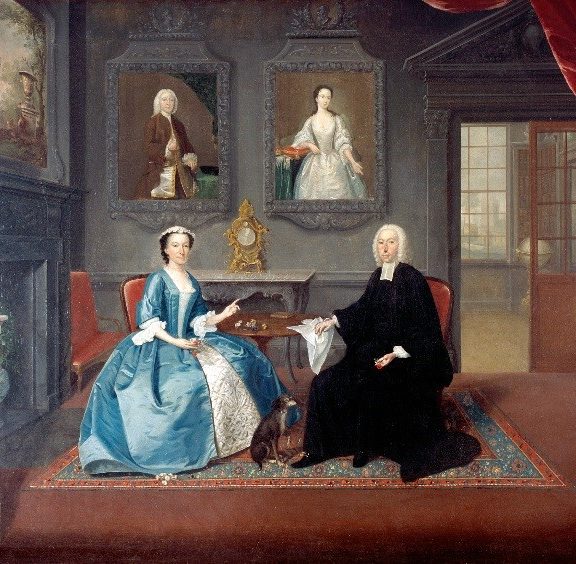
The Rev. Streynsham Master and his Wife, Margaret, of Croston, Lancashire
Date: 1742-4
Artist: Anthony Devis
The Harris holds an important collection of paintings by artists who were born or who have lived in Lancashire that dates from the 18th century to the present day. The collection includes mostly portraits and local landscapes.
Arthur Devis was born in Preston, he was the son of a cabinetmaker. Although he lived mostly in London, he maintained strong links with Lancashire and received a number of commissions from local families.
This portrait of the Rev. Streynsham Master, Vicar of Croston, and his wife Margaret is a type portrait known as a ‘conversation piece’. Fashionable in the 18th century, they show family groups or friends in informal domestic or rural settings.
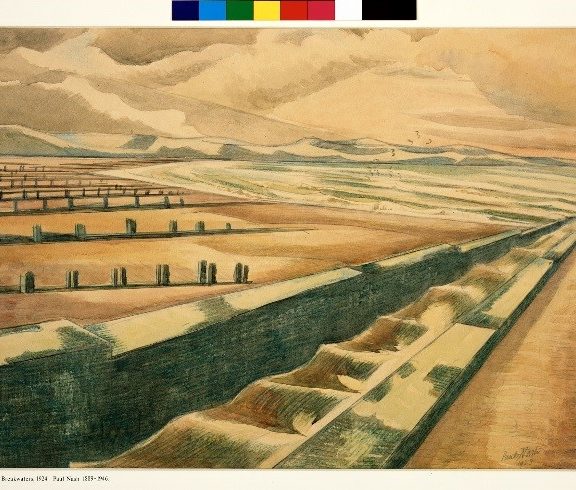
Channel and Breakwater
Date: 1923
Artist: Paul Nash
The Harris has a small but notable collection of Modern British art, including paintings by Walter Sickert, Stanley Spencer, Matthew Smith, Ivon Hitchens, David Bomberg, and Lucian Freud.
After serving in the First World War, Nash suffered a breakdown and was diagnosed with ‘war strain’. To recuperate, he and his wife rented a cottage at Dymchurch on the Kent coast.
His experiences during the war led him to consider the coast line as a conflict between the sea and land. The geometric lines reflect Nash’s early experiments with abstraction, and suggest a coordinated battle between the sea and the man-made defenses built to protect the land from invasion.
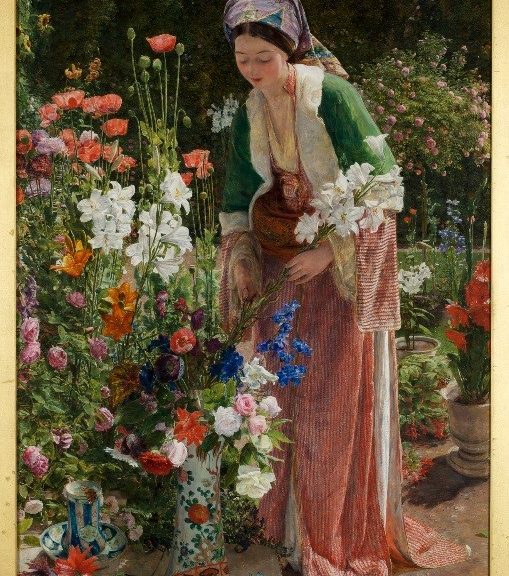
In the Bey’s Garden
Date: 1865
Artist: John Frederick Lewis
The first major addition to the Harris’ art collection was a bequest from Preston lawyer Richard Newsham in 1883. This collection of over one hundred oil paintings and watercolours by prominent Victorian artists, is still considered the core of the collection today.
A favourite painting in the Newsham Collection is In the Bey’s Garden, painted in 1865 by John Frederick Lewis. The woman in the painting is meant to be the wife of a Bey, or Turkish provincial governor but is actually the artist’s wife, Marian.
Lewis travelled widely and lived in Cairo for 10 years. Back in Britain, he continued to paint Orientalist works for the rest of his career.
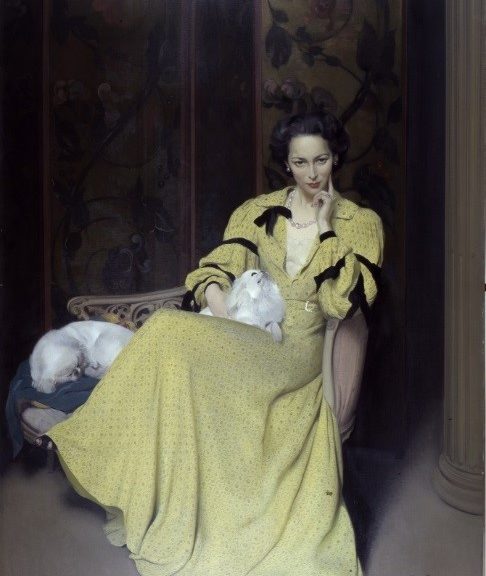
Pauline in the Yellow Dress
Date: 1944
Artist: Sir James Gunn
There are over 800 oil paintings and over 6,000, watercolours, drawings and prints at the Harris. The collection includes 18th century portraits and landscapes, Victorian and 20th century paintings, prints and drawings by British and European artists from around 1400 to the present day, and work by regional artists.
This portrait of Pauline Gunn, the artist’s wife, caused a sensation when it was first displayed at the Royal Academy in London. It was voted picture of the year and described as ‘the Mona Lisa of 1944’ by the Daily Mail.
The Harris purchased the painting. Visitors flocked to see her when the painting first arrived in Preston. They were captivated by her gaze and sometimes outraged by the yellow dress, made with extravagant amounts of fabric during war time rationing. At the time, Gunn was one of Britain’s most popular portrait painters. His seemingly effortless style brought him numerous commissions, including the Royal Family, prime ministers, and leading artistic and literary figures of the day.
Today, Pauline in the Yellow Dress is still our most popular painting.
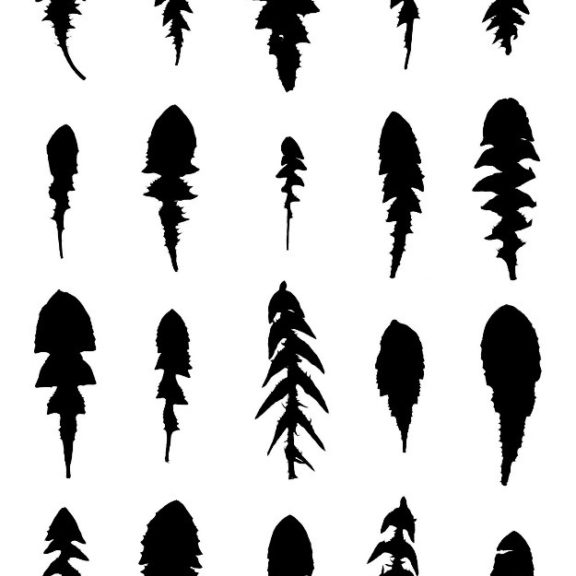
Dandelions
Date: 2012
Object number: 2018.17.1
Artist: Rebecca Chesney
In 2018 Rebecca was invited to spend time in the Harris Museum archive to discover any objects in the collection connected to the theme of dandelions. The exhibition comprised objects from the artist’s Dandelion Archive and items from the Harris collection they were placed in sixteen different locations within the museum’s displays and galleries for visitors to find.
Although seen by many as a weed, dandelions are a symbol of hope in folklore, and have fond associations with traditions like making wishes and telling the time.
The Dandelion Archive is an ongoing project where the artist explores the dandelion’s symbolism, and how it is represented in cultural collections of prints, textiles and ceramics.
